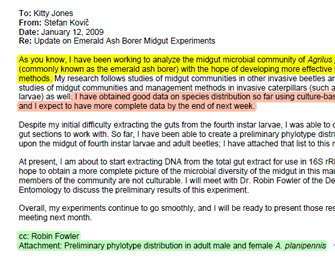« Prev Next »

Memos and Progress Reports
Determining your audience and purpose
Like e-mail messages, memos are common in many workplaces. A memo may serve as an informal proposal to pitch a new idea to a supervisor or manager. It can also provide a quick, concise way for scientists to brief each other or their supervisors about the status of a project.
As with e-mail, carefully consider who will be reading your message and what you hope to convey before you prepare your memo. For example, if you are writing a memo to propose a new project to your supervisor, you must explain why the project is necessary and worthwhile. If you are updating your reader on the status of a project, you may need to focus on how much the project has cost so far and when you think it will be completed. Then, when you begin to prepare your memo, ask yourself: Why am I writing this? Who will read it, and what will interest them the most? Answering these questions will help you determine the appropriate tone and structure for your memo.
A progress report is a specific kind of memo that summarizes recent and future work on a specific project. The exact content and format of a progress report may vary, but the purpose is the same: to let your audience know if the work is going smoothly, where you have encountered problems, and whether you are able to keep to the initial plan. Progress reports may also explain whether you can finish the project on time and within budget.
Choosing your tone
Memos are less formal than scientific papers or lengthy technical reports, but they should still show a respectful and professional tone. Unlike e-mail messages, memos should remain formal even if you know your audience well. The goal of a memo is to convey essential information quickly, so you should not distract your audience even if you are only trying to be friendly. For this reason, memos typically do not include greetings or closings.
Choosing your tone carefully is especially important if you need to deliver bad news in your memo. For example, if you are updating your manager to tell him or her that your project is running behind schedule, you should be forthright and honest — do not adopt a tone of false cheerfulness or optimism. It is your professional responsibility to explain the situation exactly as it is, not to withhold bad news to keep your audience happy. If you have bad news to deliver, express your dismay using words like "unfortunately" or phrases like "I regret to tell you that . . . ", and explain how you will solve the problem.
Memo or report structure and content
The format of a memo is often similar to that of an e-mail message. (Note, however, that if your organization has a set format for memos, you must follow that format.) Both e-mail and memos feature certain information in their headers, but unlike e-mail, memos do not include a salutation or a closing. As with e-mail, the body of a memo may include headings, subheadings, or bullet points to highlight important information — although too many bullet points will make the most important ideas difficult to identify. If you mention colleagues in a memo, send them a copy of the memo and list their names next to "cc:", just as you would include them in the "cc:" line of an e-mail. In addition, if you need to include another document (such as a preliminary budget or a detailed timeline) as an attachment, note this in the memo and include the title of that document.
The most important part of the progress report is the introduction. Here, remind the audience what the project is and why it is important. Explain who is affected by the project, when the work began, and when you expect it to end. Finally, outline in specific terms the overall status of the project so readers can see at a glance where you are and what you have left to do.
The body of your progress report should open by noting the current status of the project. Provide an outline of what parts of the project you have already completed: What important tasks have you finished? What decisions and discoveries have you made? Next, describe what work you still have to complete. Use chronological order to show your audience what steps are yet to come and how long you think those steps will take.
Even though it seems counterintuitive, you should also describe any problems that have arisen during the project. Your audience needs to know if something went wrong along the way, and they will want to know how you responded. If you solved those problems, explain how. If you did not solve them, show that you have at least one solution in mind. Think about what problems might arise, too. This will show your audience that you have thought carefully about the project and how you will complete it.
End your progress report by summarizing the current status of the project, good news, and key problems. State again whether the project will be completed on time and on budget.

Within this Subject (22)






















